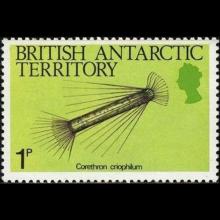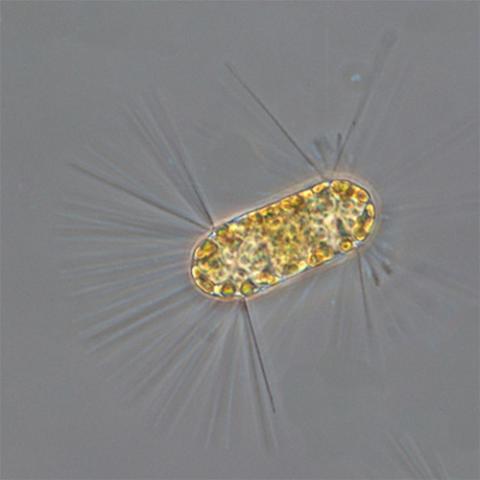NAME(S)
TAXONOMY
PLANTAE ID
THERAPEUTIC
British Antarctic Territory
Issued:
Stamp:
Corethron criophilum
British Antarctic Territory
Issued:
Stamp:
Corethron criophilum
British Antarctic Territory
Issued:
Stamp:
Corethron criophilum
Corethron Criophilum Layers in Cores from the Northwestern Weddell Sea: Implications for the History of the Larsen Ice Shelf
Athan Barkoukis and Amy Leventer, Colgate University, Hamilton, NY, April 3-5, 2002
Cruise NBP00-03 collected sediment cores from the recently accessible region of the former Larsen-A Ice Shelf, in order to assess the longer-term history of the Larsen-A and to place recent catastrophic events in their geologic perspective. Multibeam swath bathymetry of the area revealed the presence of a deep (700-900 meter) trough in which a dozen sediment cores were retrieved. These sediment cores are characterized by a consistent stratigraphy with an uppermost structureless to thinly bedded diatom-poor mud distinguished by three diatom ooze layers that have high concentrations of the diatom Corethron criophilum, a species generally rarely preserved in Antarctic sediments. Given current interest in the history of the Larsen Ice Shelf, this finding generated increased interest in the factors responsible for the formation of these unusual layers. Detailed structure of these layers, in terms of the size distribution of Corethron valves within each layer demonstrates the likelihood that these layers were formed by unusual open water "reproductive events" that have been reported in the modern ocean so far from only two regions of the Southern Ocean, the polar frontal zone of the South Atlantic and in open waters from Prydz Bay. The lateral continuity of these layers within the deeper parts of the basin suggests physical concentration of the sinking diatoms, but vertical changes in average size of the valves within individual layers do not indicate any grading. The valves are poorly preserved, with spines and girdle bands more common than whole valves, suggestive of heavy grazing by pelagic zooplankton, probably krill. The organic residues from these layers are extremely depleted in sterols (personal communication, John Hayes, WHOI), consistent with the observation of grazing, though additional factors may contribute to the sterol-poor nature of these layers. The Corethron layers are far from monospecific, with high contributions of both Fragilariopsis curta, indicative of sea ice and/or ice edge productivity, and Thalassiosira gracilis, a species often associated with a well-mixed water column. These data suggest that the Corethron layers were formed during blooms where mass sexual reproduction of Corethron was taking place, in association with both open water and ice edge phytoplankton. However, the mechanism for their emplacement within the stratigraphic succession of the Greenpeace Trough remains problematic. The pore waters associated with the Corethron layers have high concentrations of NaCl (personal communication, Randy Dirszowsky and Robert Gilbert, Queen's University), suggesting an association with the formation of high salinity shelf water but the suite of processes linking the initial bloom to the final concentration of diatom valves in the deeper portions of the trough still needs to be worked out.
Reference: academics.hamilton.edu
Genus species (Plantae): Corethron criophilum
Lifestyle
Photosynthetic. Corethron criophilum reproduces sexually and asexually (Guiry 2011). Auxospores present (Cupp 1943).
Description
Cells are solitary and cylindrical, with semi-spherical valves. One valve has a ring of long spines directed outwards. The other valve has a set of similar spines facing inwards and another ring of short, hooked spines also directed outwards. Chloroplasts are numerous and discoid (Cupp 1943, Horner 2002).
"The spines are attached to the valve by a kind of ball and socket joint. Hooked spines are delicate and easily lost" (Horner 2002). Intercalary bands are collar-like but indistinct (Cupp 1943).
Measurements
Length (pervalvar axis): 20 - 300 μm
Diameter: 5 - 38 μm
(Hendey 1937, cited in Hasle and Syvertsen 1997; Cupp 1943)
Similar species
None. Has unique pill shape with two rings of long spines directed towards one end and a crown of shorter hooked spines pointed the opposite way (pers. comm. D. Cassis).
Harmful effects
May cause physical obstructions in gills of farmed salmon (Whyte et al. 1997). Concentrations of ∼400 to ∼800 cells mL-1 have been recorded with low-level irritation but no fish mortalities; harmful concentration is probably around 500 cells mL-1 (Haigh 2010).
Reference: www.eoas.ubc.ca
Photo: www.algaebase.org


